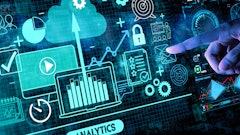
Most great superheroes have cool gadgets. Captain America has the shield; Wolverine has claws; Thor has Mjolnir; Iron Man has his suit, and so on. They use these gadgets to fight evil and protect the universe. Our supply chain and logistics partners are the world’s modern day superheroes because they have been delivering essential rations despite global crises. They fight through supply chain disruptions caused by pandemics, natural disasters, cyberattacks, and everything else to deliver the goods that the world depends upon. Over the last two years, during the pandemic, the shortcomings of the global supply chain have been evident as we have suffered shortages of goods from computer chips to toilet paper. It impacts enterprises and households, 94% of Fortune 1000 companies faced supply chain disruptions due to the pandemic. We need to equip our logistics superheroes with powerful gadgets that they can use to manage chaos and save the universe. The good news is that the technology is already here with 5G, the Fifth Generation for broadband cellular networks, and IoT, the Internet of Things. Both are possible weapons that the Batmans and Robins of the logistics industry can use to save the day.
Digitization of the supply chain for streamlining operations is not new. A Deloitte report states that companies must improve end-to-end supply chain visibility through digitization. The combination of 5G and IoT bring benefits and capabilities that surpass what was previously possible. Just as no single gadget can fight all villains, no technology or solution can fix all supply chain issues. We have all admired James Bond for his savvy use of different devices in different situations to beat his foes. Similarly, we need to look at the dynamic duo of 5G and IoT.
5G is a wireless connection technology that can deliver multi-gigabit speeds at lower latencies. It can handle many connections per cell tower, making it the ideal solution for connecting IoT devices. These IoT devices can relay information, pinpoint their location, take proactive measures, and respond to remote commands depending upon their capabilities. 5G and IoT can combine to perform complex tasks in the supply chain and unlock new efficiencies and enable smarter business decision making.
The ability to track and trace every shipment is essential. Historically, supply chains have relied on stale and manual methods of tracking. With 5G and low-cost IoT sensors, the entire logistics process can be transformed by bringing near real-time visibility to the state of goods, their location, conditions, and estimated arrival times. This valuable information can help manufacturers prepare efficiently, stores can anticipate stocking needs, and hand-offs in transportation can occur seamlessly. In the United States, around 30-40 percent of the food is wasted due to spoilage from production to delivery. 5G and IoT can trace the risk of spoilage while in transit due to overstocking or equipment malfunction. Temperature and ambient light sensors can indicate if a product has been damaged or exposed to sunlight. This food can be rerouted to a closer destination, or the equipment can be repaired, saving the products to feed people in need.
5G and IoT can significantly enhance warehouses, ports, shop floors, and factories. They can enable smart inventory, tracking, autonomous operations, and inspections within a location. Automation reduces losses due to missing parts, counterfeiting, and theft. Crewless vehicles and drones operated via remote control or autonomous vehicles can optimize loading and unloading operations connected via 5G by keeping vehicles in lanes and avoiding collisions. Advanced sensors and high throughput, low latency 5G connections can enable autonomous inspection of products by connecting mobile and fixed cameras to AI applications at the edge.
Virtual (VR) and augmented reality (AR) over 5G networks with IoT sensors can provide remote assistance when required. They can allow for visualizing stocking options in warehouses so that businesses can utilize their space efficiently. Mixed (MR) reality can help spot issues before implementation. 5G and IoT-enabled virtual reality can be used for simulations and training so that routes and processes are fully optimized before products are sent.
Manual processes result in bottlenecks and blind spots in the supply chain. Our logistics superheroes need to focus their energy on creative pursuits and reimagining business models to improve efficiency, reduce costs, and enhance accuracy. Digitization with 5G and IoT will ultimately benefit the consumer. The dynamic duo of 5G and IoT are the perfect gadgets to digitize the supply chain. A McKinsey survey states that nearly 90 percent of supply chain executives said they expect to overhaul their IT within the next five years. Companies must adopt 5G and IoT as gadgets to empower our logistics superheroes to deliver the goods and make the world safer, smarter, and more sustainable.




















